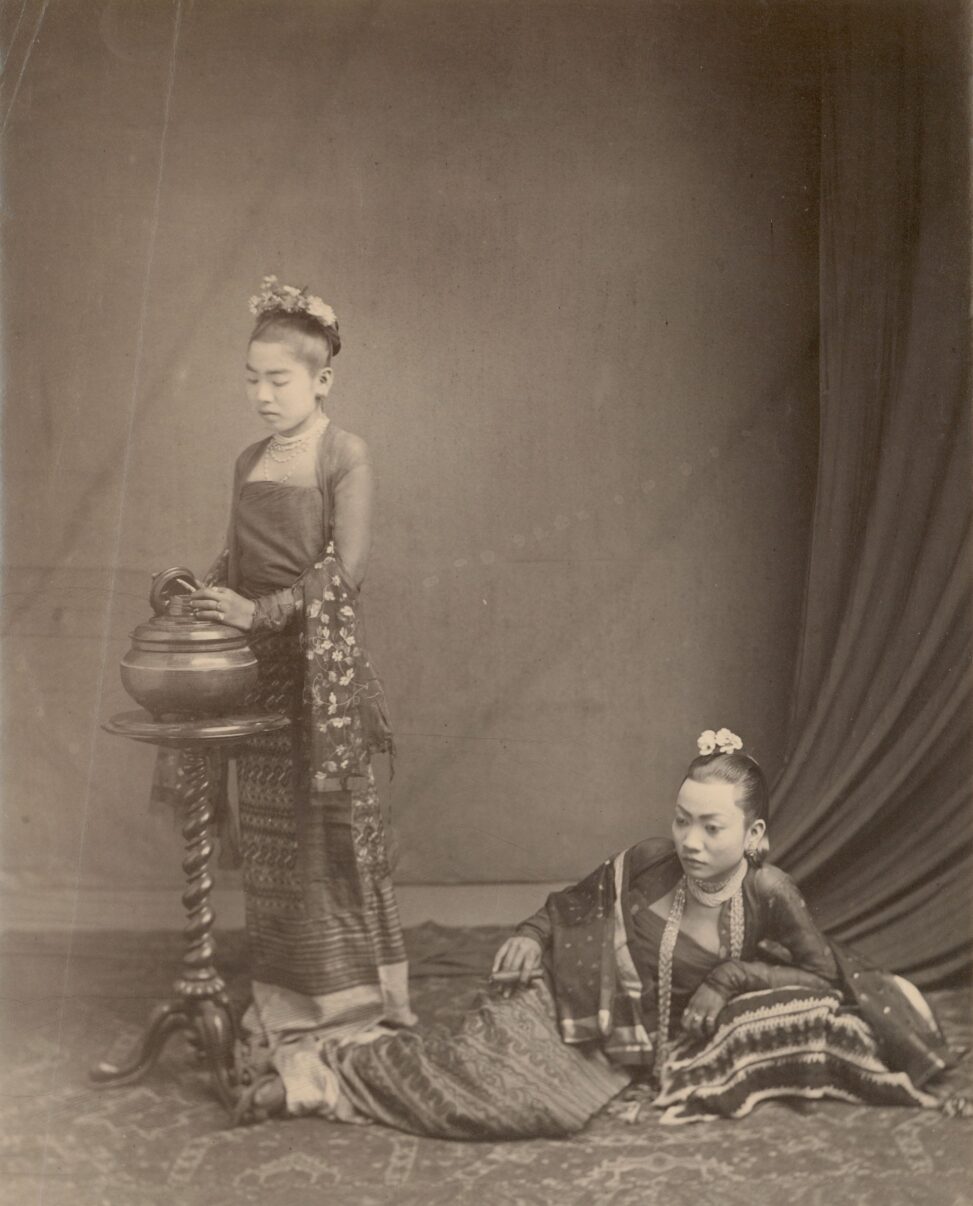I have chosen to analyze the photograph titled “Burmese Ladies of Wealth,” taken between 1885 and 1895, in the region of Burma (also known as Myanmar). The photographer is likely a British colonist who lived in Burma during the 1880s. The photograph falls into the category of public domain under US law. The image depicts two women, dressed up with fine clothing and jewelry, with stern facial expressions. One woman looks to be middle aged with a cigar in her hand. The other girl seems to be undergoing adolescence and is holding a cigarette above an urn. The photograph in itself is posed, and it represents the wealth and riches of certain communities in that region. The photographer had to make certain stylistic choices to represent the wealth. He was able to do this by dressing the women in what looks to be expensive traditional Burmese clothing. Alongside that, both ladies are layered in jewelry as well as flowers. The photo suggests that there was probably a large wealth disparity gap between the wealthy and the poor around that time. It highlights the importance of tradition and culture in the community as a sense of pride and well being.
The history of Burma around the late 1880s and the early 1890s follows the third Anglo-Burmese war. The war was sparked by King Thibaw who refused to allow the British commercial interests in the northern parts of Burma and also refused to allow a British resident to stay in Mandalay. Britain took this as a threat because they had already annexed lower Burma and did not want to lose their commercial interests in upper Burma. Therefore, they launched an attack. This picture does not really highlight what was happening in the region at the time. It does, however, highlight the impact Britain had on Burma. When looking at the photograph, it is quite clear that both ladies are holding some substance in the form of a cigarette and a cigar. The influence that Britain had on Burma must have led to the rise in use of cigars and cigarettes. It also shows the irony of the photo. The image was not taken as a natural occurrence, but rather one that had to be set up in a specific way. It is interesting that the British colonist, who is probably the photographer, opted to dress up the woman in traditional clothing, however, added western elements in the photo.
For the artist, this image was probably a way to remember his travels in Southeast Asia. It was also probably a way to depict how the wealthy are in Burma to his fellow colleagues. By dressing up the ladies to look rich, he encapsulates the wealth disparity gap in the picture because the rest of the album and other photos taken in Burma during that time show something different. They showed the landscape and people were like, some living with barely any means. There is a lot of irony in this photo, and it might have been a purposeful choice to force the viewer to understand the effects of colonialism and globalization. We see this all around us, and even in an image that was meant to capture traditionally Burmese women who were upper class, there are still British influences on the picture.
The title of this image, “Burmese Women of Wealth,” tells the audience more about what the photographer was trying to accomplish with the photo. Upper class women were expected to adhere to strict gender roles and take care of things at home. It seems as though the photographer is trying to depict the wealthy in a feminist sense, while juxtaposing it with masculine features such as stern expressions, cigarettes, and cigars. This is even more paradoxical when analyzed with the use of feminine clothing, jewelry, and lots of flower head pieces. During this time of conflict with the start of the third Anglo Burmese War, women did not play much of the role because it was a patriarchal society.
Overall, the image highlights many key features that are not so obvious at first glance. After realizing that the photo was posed and meant to be a way to capture traditionally rich women by a British colonialist, there is much more to take in and understand. It would be interesting to see the color palette the photographer chose and whether or not it has more of a British influence or follows traditional Burmese culture. Nonetheless, the image portrays much more than just two ladies looking off into the distance.
References
Beckett, I. (2021). The Third Anglo-Burmese War and the Pacification of Burma, 1885–1895. In S. Miller (Ed.), Queen Victoria’s Wars: British Military Campaigns, 1857–1902 (pp. 220-239). Cambridge: Cambridge University Press. doi:10.1017/9781108785020.011
Council on Foreign Relations. (n.d.). Myanmar’s troubled history: Coups, military rule, and ethnic conflict. Council on Foreign Relations. Retrieved April 26, 2023, from https://www.cfr.org/backgrounder/myanmar-history-coup-military-rule-ethnic-conflict-rohingya
Choragudi , U. (n.d.). Survey shows inequality a serious problem in Myanmar. Retrieved April 27, 2023, from https://www.mizzima.com/article/survey-shows-inequality-serious-problem-myanmar
